It’s the Weather
When I asked last week how spring has been so far this year, only one of you wrote in with anything to say. And that person was a Montanan from Caras Nursery & Landscape, Jeri Zirbel, who said it was snowing with temperatures between 35F and the teens. As for what’s selling, it’s houseplants. “No takers yet on pansies, hellebores and etc.,” Jeri said.
Maybe the rest of you are too busy selling to write in with your status. Or, perhaps you are dealing with weather issues of your own, such as rain and snowmelt-related flooding and mudslides in California. Our Amsterdam-based retail trendspotter, Stacy Sirk, is currently in the state and sent me a weather-appropriate display she saw at the Cupertino Summerwinds Nursery.
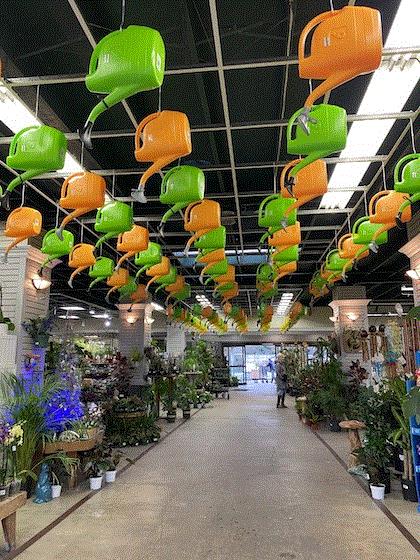
From the footprints on the floor, it appears it is raining—outside, not from all those watering cans above. Stacy commented that this is a high-impact visual display that took little effort to make happen (unless the hanger upper is scared of ladders, I would imagine). And no one is rushing out to buy watering cans at the moment, so put your inventory to work for you until they do.
Maybe this week’s responses to my “How’s your week been?” question will be from folks in New England who are digging out from under 2-plus feet of snow. Or cleaning up debris from twisters in the southern regions. Or maybe, selling up a storm in places where the weather is picture perfect. If you’re in any of those situations or one of a myriad more, drop me a note about how it’s going and what’s selling the most (or not at all). Email me HERE.

Another Garden Implement Idea
This one comes from me. I spotted this fun resting spot at a local indoor market.
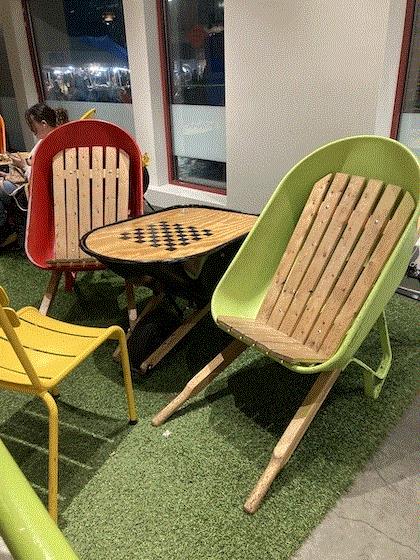
The worrywart in me is hoping those handles are triple-reinforced and that there’s something preventing the barrow from tipping backward. Oh wait, there is:
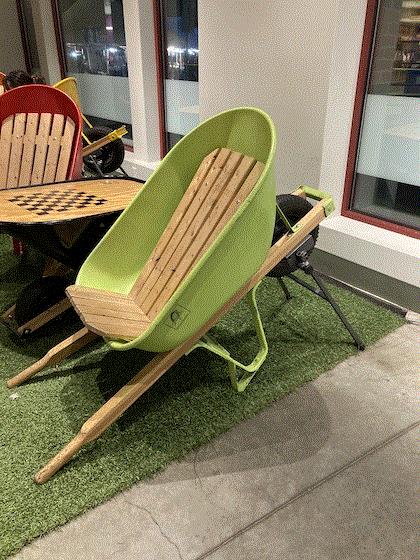
Whew, that makes me less anxious. The best part about this place of relaxation is that you can wheel it to where you want it. Choose a sunny spot on a cool spring day or shade for the summer. And maybe that checker board barrow can be whatever you want it to be. Try your hand at it and let me know.
Got any great springtime quick-turnaround display ideas using whatever you have on hand? Drop me a note about it HERE.
Webinar Alerts!
More and more Americans are taking up and doubling down on regenerative gardening techniques to help draw down atmospheric carbon dioxide levels. Green America has more than 20,000 registered gardens signed up in the organization’s Climate Victory Gardens programs, up from around 14,600 last year. One regenerative gardening technique—limiting water use—is becoming increasingly embraced by folks who are giving up or sizing down their water-guzzling grass lawns.
The folks at Green America are sponsoring two webinars about how to downsize or replace grass lawns. Those webinars are:
Just click on the webinar title and that'll take you to the registration page.
The following is why I think you should educate yourself and your team about the topic: I recently posted to my town’s Facebook page looking for a local service that could help me find an alternative solution to my grub-infested lawn. All of the responses came back with chemicals to apply and varieties of grass and clover they’d use, and nothing with a non-grass lawn solution. Let your business be the non-grass lawn solution.

Growing In Straw Bales
On the topic of growing things differently, I’m sure you’ve heard of the concept of growing a garden in a straw bale. Joel Karsten wrote the book about it in his book “Straw Bale Gardens” in 2013, and then followed up with “Straw Bale Gardens Complete” in 2018. He’s out with the second edition of that second book with updated information on using straw bales for mushrooms, creating a “greenhouse” with bales as the heater for the structure, for dry-climate gardening and also how to use them in small-space gardens. There’s even info on how to create your own bales from compostable materials. That sounds really cool.
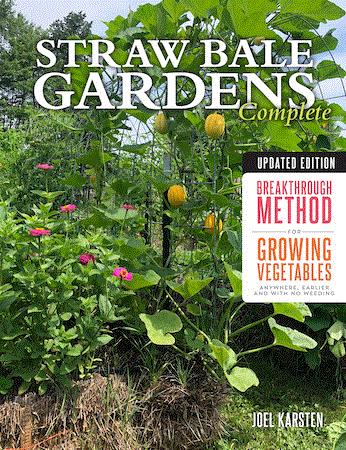
Joel has developed a product called BaleBuster that can be used on the bales to get them ready for planting. It’s a bale conditioner, of sorts, and includes a formulation of fungi, bacterial spores and nitrogen, with organic and refined versions available.

Joel tells me it’s a great item for IGCs because it helps to make starting a vegetable garden so very easy. “The gardener sprinkles it on the bale, waters it in and waits 12-18 days to plant,” he wrote in an email. “They are almost 100% successful at getting a crop, which is wonderful, because success breeds enthusiasm and you can get a young person hooked on gardening for life.”
You can order the books and BaleBuster HERE. You’ll find contact information on that page, as well, if you have any questions.

Growing in Gray Pots
To carry the running theme of growing differently, I saw this item in colleague Jen White’s most recent GreenTalks newsletter. She mentioned that Pöppelmann Teku is introducing a new line of plant pots called Baseline, meant to be an alternative to the standard black pot. These Baseline pots are made of 100% post-consumer recyclate (PCR) and can be completely recycled after use. Available in gray, they say the lighter color will help during sorting at recycling.
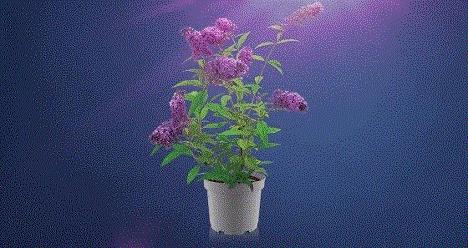
Baseline joins the Pöppelmann Group’s Circular360 category, which pursues resource conservation and a circular economy philosophy. The company has a goal to have all in-house made packaging to be 100% recyclable by 2025. Considering that there are 21,000 pieces of plastic in the ocean for each person on the planet—and the ocean’s plastics pollution is doubling every six years–this is a necessary step to slow that pollution.
More Money for Students
Last week I mentioned the HRI and Sidney B. Meadows Scholarship Endowment Fund that are available for horticulture students. This week I have more money leads for you, this time from the American Floral Endowment (AFE). They have nearly 30 scholarships available for undergrads and graduate students. If you head ONLINE HERE, you can find descriptions of each scholarship, as well as application requirements. If you are studying horticulture or floriculture, head on over to that site and see what you might be eligible for—and then apply. That’s the critical step!

Applications must be submitted by May 1—so you have a little over a month. Get on it!
Twitter Video Marketing Course
I don’t do Twitter, but that doesn’t mean you don’t find the platform useful for reaching out to or understanding your customers. Make your Twitter time even more useful and effective with video marketing advice straight from the source.

Twitter just announced that they are offering an eight-part series on video marketing called “Unskippable,” created by Twitter’s own creative team. What sounds cool about the series is that, even though there are certain tips for video marketing, they offer the tips as a guide and not as a checklist. For instance, if they have 10 tips that they know work well for video marketing, they suggest using whichever combination of tips work for whatever message you’re trying to get out into the world. Otherwise, they say, your video will lose its message and its entertainment value.
Like most things on the Internet these days, these videos are short—less than 2 minutes each—and easily digestible. Topics include “Creating Attention,” “The Right Video Size,” “Pairing Copy & Captions,” “Breaking the 4th Wall” and more. Find more information HERE.

From Overwhelmed to Connected
If you’re dreading the garden center’s spring rush because you remember how overwhelmed it left you last year, I’ve found some advice on how to turn it around. A study from the folks at Keap found four different types of small business owners: Overwhelmed (28%), Gratified (26%), Growth-Focused (25%) and Connected (22%). The Overwhelmed type struggled to manage and grow their businesses while the Connected were deeply committed to their customers and emotionally invested in their businesses.

Does that look like you in your office except with breeder catalogs and nursery pots?
Going from Overwhelmed to Connected, according to Keap, means investing in and employing systems to help take some of the burden off the owners. Ways to automate sales and marketing, scheduling, e-commerce and the like can free up time for small businesses to spend more time connecting to their customers and—gasp—taking time for self-care (take a walk, get a haircut, catch up on “Ghosts”).
The Keap interviewee in THIS PIECE has four suggestions for moving from Overwhelmed to Gratified (where small business owners genuinely enjoy working in their businesses and believe they can handle whatever challenges come their way) and then on your way to Connected. Automation and delegation are the first two. READ ON to find out the other two.

Is Customer Service Getting Worse?
The ratings are, anyway. That is according to the National Customer Rage Survey. Who knew there was such a thing? Anyway, on the other side of the coin, numbers indicate that customers are getting ruder and more uncivil, as well. Does any of this stem from worker shortages or from higher expectations?
The above comes from an NPR segment I heard yesterday on All Things Considered. You can read and listen to it HERE. The takeaway from this piece is this: The interviewee, Ama Tenumah, said a business’s first customers are its service employees, and they should be trained and treated with respect so they can do their best job. Ama is the author of a book that should be on your reading list, “Waiting for Service: An insider’s account of why customer service is broken and tips to avoid bad service.”
Forests Are Being Zombiefied
Zombie forests are marching through California’s Sierra Nevada mountain range. Well, not marching, as trees don’t actually walk (unless they exist in Middle Earth). But they are existing. In fact, 20% of the conifers in the Sierra Nevada, especially in the lower elevations of the range, are living in “zombie forests.” In other words, they are living in areas where the climatic conditions are too warm for them.

If you’re a fan of conifer forests in the western U.S., you should know that these stands of trees are just one natural disaster (fire, anyone?) from burning down and never rising again. How should this inform your garden center stock? Your recommendations? Perhaps your own actions as they pertain to climate change? That’s a great question. This SMITHSONIAN article shares some painful insights into what’s happening in that area.
Questions, comments, suggestions? Drop me a line if you'd like at ewells@ballpublishing.com.

Ellen Wells
Senior Editor
Green Profit
This week's BuZZ! was sent to 24,738 loyal readers!
If you're interested in advertising on BuZZ! contact Kim Brown ASAP!